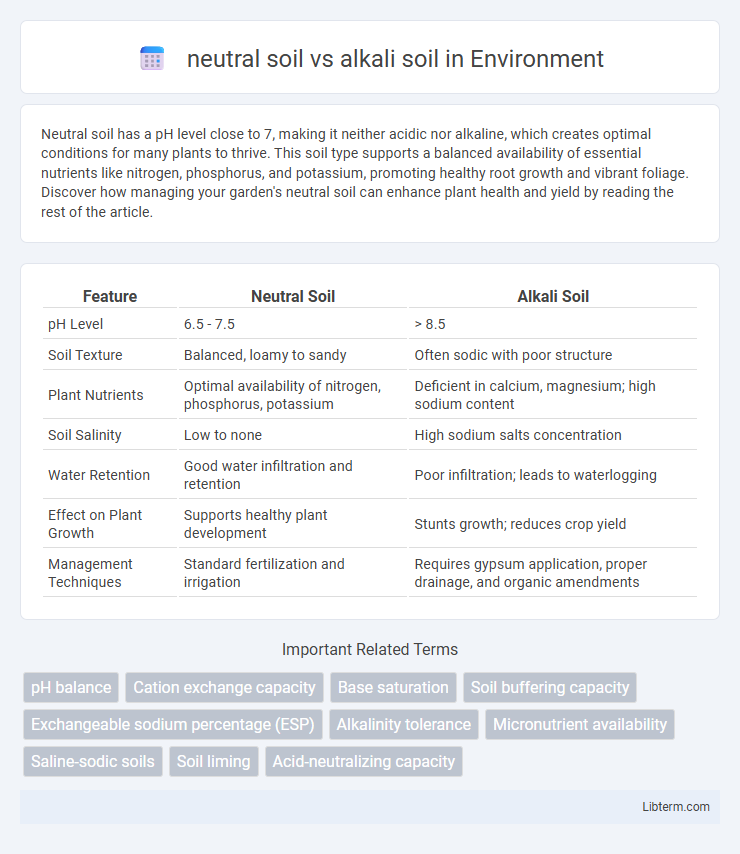Neutral soil has a pH level close to 7, making it neither acidic nor alkaline, which creates optimal conditions for many plants to thrive. This soil type supports a balanced availability of essential nutrients like nitrogen, phosphorus, and potassium, promoting healthy root growth and vibrant foliage. Discover how managing your garden's neutral soil can enhance plant health and yield by reading the rest of the article.
Table of Comparison
| Feature | Neutral Soil | Alkali Soil |
|---|---|---|
| pH Level | 6.5 - 7.5 | > 8.5 |
| Soil Texture | Balanced, loamy to sandy | Often sodic with poor structure |
| Plant Nutrients | Optimal availability of nitrogen, phosphorus, potassium | Deficient in calcium, magnesium; high sodium content |
| Soil Salinity | Low to none | High sodium salts concentration |
| Water Retention | Good water infiltration and retention | Poor infiltration; leads to waterlogging |
| Effect on Plant Growth | Supports healthy plant development | Stunts growth; reduces crop yield |
| Management Techniques | Standard fertilization and irrigation | Requires gypsum application, proper drainage, and organic amendments |
Understanding Soil pH: Neutral vs Alkali
Soil pH is a critical factor influencing nutrient availability and plant growth, with neutral soil typically ranging from pH 6.5 to 7.5, offering optimal conditions for most crops. Alkali soil, characterized by a pH above 8.5, contains high levels of sodium carbonate, leading to poor soil structure and reduced fertility. Managing soil pH through amendments like gypsum for alkali soils or lime for acidic conditions ensures balanced nutrient uptake and sustainable crop productivity.
Key Characteristics of Neutral Soil
Neutral soil has a pH level close to 7, which supports balanced nutrient availability and optimal microbial activity. It typically contains organic matter in moderate amounts, ensuring good soil structure and moisture retention. Unlike alkali soil, neutral soil does not exhibit high sodium content or poor drainage, making it suitable for a wide variety of plants.
Defining Alkali Soil and Its Properties
Alkali soil, also known as sodic soil, is characterized by a high pH level exceeding 8.5 and contains excess sodium ions that disrupt soil structure. This soil type exhibits poor water infiltration, reduced permeability, and nutrient imbalances, negatively affecting plant growth. In contrast, neutral soil maintains a balanced pH around 6.5 to 7.5, promoting optimal nutrient availability and healthy microbial activity.
Major Differences Between Neutral and Alkali Soils
Neutral soil displays a balanced pH around 6.5 to 7.5, promoting optimal nutrient availability and microbial activity, whereas alkali soil has a high pH above 8.5, leading to reduced nutrient solubility and poor plant growth. Neutral soil typically contains balanced amounts of calcium, magnesium, and potassium, while alkali soil is characterized by excess sodium ions that cause soil dispersion and poor structure. The salinity levels in alkali soil increase osmotic stress to plants, contrasting with the non-saline nature of neutral soil, which supports healthy root development.
Effects of pH on Plant Growth
Neutral soil with a pH around 6.5 to 7.5 offers optimal nutrient availability, promoting healthy plant growth and efficient root development. In contrast, alkali soil, typically with a pH above 8.0, limits nutrient solubility, causing deficiencies in essential elements like iron, manganese, and phosphorus, which stunts plant growth and reduces crop yields. High pH in alkali soil also disrupts soil microbial activity, further impairing nutrient uptake and plant health.
Common Plants for Neutral vs Alkali Soils
Neutral soil supports a wide range of plants including tomatoes, carrots, beans, and roses, which thrive in pH levels between 6.5 and 7.5. Alkali soil, characterized by a pH above 7.5, favors salt-tolerant plants such as barley, asparagus, and lavender that can withstand high pH and sodium content. Understanding soil pH is crucial for selecting compatible plants to ensure optimal growth and nutrient availability.
Identifying Neutral and Alkali Soils in Your Garden
Neutral soil has a pH level close to 7, making it neither acidic nor alkaline, and supports a wide variety of plants by maintaining balanced nutrient availability. Alkali soil, with a pH above 7.5, contains high levels of sodium carbonate, causing poor water infiltration and nutrient deficiencies, which can inhibit plant growth. Identifying soil type involves simple pH testing using kits or meters, observing plant health, and noting soil texture and color differences, where alkali soils often appear lighter and more crusty.
Managing and Amending Alkali Soils
Managing alkali soils requires effective amendment practices such as applying gypsum (calcium sulfate) to replace sodium ions with calcium, improving soil structure and permeability. Incorporating organic matter enhances microbial activity and soil fertility, while proper irrigation facilitates leaching of excess salts beyond the root zone. Monitoring soil pH, electrical conductivity, and sodium adsorption ratio ensures targeted treatment for optimal crop growth in alkali-affected fields.
Soil Testing: Determining Your Soil Type
Soil testing involves measuring the pH level to determine whether soil is neutral or alkaline, with neutral soil typically having a pH around 6.5 to 7.5, while alkali soil exhibits a pH above 7.5, indicating higher salinity and sodium content. Precise soil analysis includes testing for nutrient availability, electrical conductivity, and sodium absorption ratio, which influence plant growth and soil health. Accurate soil type identification through laboratory testing guides appropriate amendments and management practices for optimal crop yield.
Best Practices for Cultivating in Neutral and Alkali Soils
Neutral soil with a pH around 6.5 to 7.5 supports balanced nutrient availability, making it ideal for most crops; best practices include regular soil testing, maintaining organic matter through compost addition, and appropriate irrigation to prevent nutrient leaching. Alkali soil, characterized by a high pH above 8.5 and excess sodium, requires amendments such as gypsum application, incorporation of organic matter to improve soil structure, and planting salt-tolerant crop varieties to mitigate soil toxicity and enhance plant growth. Efficient drainage management and periodic leaching are critical in alkali soils to reduce salt concentration and restore soil fertility for sustainable agriculture.
neutral soil Infographic

 libterm.com
libterm.com